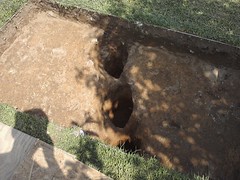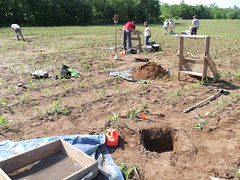Although lying on your stomach to dig holes deeper than your arm, spending most of the day working outside in 90-degree heat, and getting to know soil on a personal level are the types of things that many people go to college precisely to avoid doing, that is how I spent six weeks of my summer with Penn State’s archaeological field school.
This year’s field school was at the site of Fort Shirley–a British outpost from the French and Indian War located a bit over an hour’s drive south of State College. On ground level, nothing remains of Fort Shirley today. The site looks no different than a field you might see on any small farm in central Pennsylvania. Below the surface, however, remains fascinating traces of this once-important settlement.
Fort Shirley is unique among British forts of the era in that there was a Native American settlement nearby, making it an area of cultural intersection. Although it is difficult to imagine today, central Pennsylvania was, at that time, the frontier of British settlement. So by excavating Fort Shirley, we hoped to get a better idea of how the natives and the colonists interacted.
Archaeology is a branch of anthropology, meaning that its purpose is to gain a better understanding of human behavior. While popular culture tells us that archaeology is about looking for buried treasure, the things that can be most academically useful are often, in fact, buried trash. For example, if you were to dig up a gold ring, it might tell you nothing more than that the people in that time period had a fondness for jewelry–as do virtually all people in most historical eras. But if you were to dig up half of a broken rum bottle, as I did, it could be very helpful in understanding these people’s living conditions. Fort Shirley was not built directly by the British military, but was commissioned to an Irish trader named George Croghan. Because this fort was not as well-funded as others, the militia members often settled for being paid in alcohol rather than cash. So that broken rum bottle I found was probably the hard-earned wages of a man who lived over two hundred years ago.

A detailed description of archaeological methods would take far more than a blog post to explain, so, in short, our work consisted of digging up soil and then sifting it through a screen to find artifacts. We spent the first two weeks in a corn field looking for the native village that historical records say was located near the fort. One thing that made this field school very interesting was that the area was inhabited for millennia, so while looking for artifacts from the 1750’s, you would frequently find an arrowhead or other stone tool from 5,000 years ago. Remains from the village were sparse, but once we moved to the fort for the remaining four weeks, artifacts were far more plentiful. We mostly excavated the walls of the fort. You could see where they once were because the deep spots where the logs were buried had filled in with darker soil.
The great thing about archaeology is that it engages both the body and the mind. While I was developing my digging and screening skills, I could contemplate objects I found and try to envision what life at Fort Shirley was like. As you dedicate more and more time to the excavation, you gain a sense of satisfaction with new finds, such as near the end of the dig when, after being one of the few people who had not found a native trade bead, I found five in one day. Learning to recognize important artifacts is also something that comes with experience. When the faculty were examining our finds on one of our lab days, I learned that what I thought was a useless piece of metal was, in fact, a jaw harp–a popular instrument from the time. I remain in awe of one of the instructors who, after examining a shard of pottery or glass for a few seconds, could tell you about what year it was made and where.
Even more than most disciplines, archaeology is one that requires first-hand experience to really understand. I couldn’t ask for a better introduction to it than this field school, and I would wholeheartedly recommend it to anyone with an interest in it.

